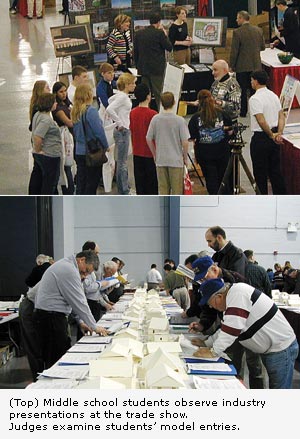Building a Future in KC's Construction Trades
![]()
 To prepare for the competition, middle-schoolers work in teams of two or three to design buildings, draw scaled plans, estimate costs and construct three-dimensional foam core models. No ginger-bread houses or card castles; this is big-time professional.
To prepare for the competition, middle-schoolers work in teams of two or three to design buildings, draw scaled plans, estimate costs and construct three-dimensional foam core models. No ginger-bread houses or card castles; this is big-time professional.
On March 4, the UMKC Center for Construction Excellence ushered more than 3,000 of the area's young and pliable minds into the Fifth Annual Middle School Design-Build Competition. It was held at the MCC Business and Technology Center in Kansas City, Mo.
The Center for Construction Excellence's event grew as a result of research showing that students stop choosing math, science and English courses as they move into high school. "By demonstrating to students how these subjects are used in the real world of construction, it is hoped that they will continue to take upper-level math, science, English and technology classes and become better- prepared to enter the world of work or college," explains Dr. Janet Paulson-Smith, the Center's executive director.
More than 100 construction, engineering, contracting firms and labor unions sponsored the event. Construction spending averages almost $700 billion per year in the U.S. and is the country's second largest employer, with over seven million workers in the industry. However, govern-ment reports confirm the construction workforce is dwindling. Fewer high school and college students are interested, or have the necessary skills, to pursue the field. Robin Floyd, marketing manager at Turner Construction Co., explains the need for a new batch of bright minds: "In the next decade, we'll lose a lot of skilled workers to retirement," she says. "Young people just aren't encouraged into construction. They may think of it as 'unglamorous,' get-your-hands-dirty. Where the truth is, there's much more to this industry than swinging a hammer--there are countless professional, lucrative opportunities."
From Appleton City RII to Yeokum Middle School in Belton, 54 schools entered the Design Build Program to be eligible for the competition. In the fall, the Center for Construction Excellence approaches area schools with the program. Teachers who offer the program receive instruction on the various disciplines necessary to deliver it to their students. In return, teachers are given three graduate-level hours of continuing education credit. The Best Overall Award went to Ryan Ferguson and Adam Kraft of Brittany Woods Middle School in University City, where the Design Build program was incorporated into a school-wide science project contest. Math teacher Mary Sampson hadn't learned of the program until January, when she quickly recruited a team of teachers to teach the concepts to seventh and eighth graders. They formulated a project in which 100 students built a creative house model using their imaginations--and scientific reasoning. Students who met the February deadline brought their models to the Design Build Competition. Ferguson and Kraft's model sailed all the way to the top. "We wanted to make a good design with a lot of appliances, but of course we had to limit it to the $50,000 budget. We had to think of the cost of labor and the cost of cutting down trees and choose the right housing area," says Kraft.
Judges comprised of more than 300 construction and design industry staff. The day's events included an industry trade show where middle-schoolers could participate in interactive demonstrations. Participating firms included Black & Veatch, Turner Construction, Honeywell and Kansas City Power and Light Company, to name a few. Bottom line: in occupational surveys given to junior and senior high school students, out of 250 occupations, construction ranks 248th (edging out custodial care and migrant farm work). The Center for Construction Excellence will continue to educate and involve the area's youth in a grand effort to mold minds and open eyes to the unlimited opportunities--building the industry's future success stories, one contest at a time.![]()